summary or book review of Island of Shame by David VineSolut
Solution
The American military base on the island of Diego Garcia is one of the most strategically important and secretive U.S. military installations outside the United States. Located near the remote center of the Indian Ocean and accessible only by military transport, the little-known base has been instrumental in American military operations from the Cold War to the war on terror and may house a top-secret CIA prison where terror suspects are interrogated and tortured. But Diego Garcia harbors another dirty secret, one that has been kept from most of the world--until now.
Island of Shame is the first major book to reveal the shocking truth of how the United States conspired with Britain to forcibly expel Diego Garcia\'s indigenous people--the Chagossians--and deport them to slums in Mauritius and the Seychelles, where most live in dire poverty to this day. Drawing on interviews with Washington insiders, military strategists, and exiled islanders, as well as hundreds of declassified documents, David Vine exposes the secret history of Diego Garcia. He chronicles the Chagossians\' dramatic, unfolding story as they struggle to survive in exile and fight to return to their homeland. Tracing U.S. foreign policy from the Cold War to the war on terror, Vine shows how the United States has forged a new and pervasive kind of empire that is quietly dominating the planet with hundreds of overseas military bases.
Island of Shame is an unforgettable exposé of the human costs of empire and a must-read for anyone concerned about U.S. foreign policy and its consequences
Almost in the middle of the Indian Ocean lies the Chagos Archipelago, a place which visually comes fairly close to the image most people have of paradise. Unfortunately for its inhabitants, the islands are also very conveniently located, a fact which led the United States and United Kingdom to expel these people from their apparent paradise into abject destitution in order to turn the place into one of the world\'s most important military bases. Vine\'s book is the best account of this sordid tale so far.
The islands were originally unpopulated and eventually annexed by France in the eighteenth century. From 1783 onwards African slaves were brought to the islands to work on coconut plantations, eventually supplemented by Indian indentured labourers. Their descendants inhabited the islands until forcibly expelled in the late 1960s. The islands were ceded by France to Great Britain in 1814 and until the mid 20th century there was little to differentiate the islands from similar remote places so aptly described by Jean-Claude Guillebaud as essentially worthless confettis de l’empire.1This bucolic simplicity changed dramatically in the late 1950s through the US Marines’ so-called Strategic Island Concept. Based on its experience in the Pacific war against Japan, the military recognized the value of strategically located island bases throughout the world\'s oceans. In order to forestall the negative influence of unreliable independent governments in the decolonizing world, the concept called for the installation of US bases in territories under complete US control. In execution of this policy, the US military leadership identified a number of, preferably uninhabited, islands (Danish Virgin Islands, Thule on Greenland, Keflavik on Iceland, parts of the Bahamas, Aruba, Turcs and Caicos, Cocos Islands, etc.) which were subsequently fully or partially bought or leased from friendly Western governments. Likewise, the US took over a number of former mandates (Saipan, American Samoa, Marshall Islands, the Trust Territory of the Pacific Islands, etc., see at 53 in the present volume) from Germany and Japan under the guise of ‘temporary administration’ in order eventually to annex them for military purposes. These bases supplemented those installed on US overseas territories already acquired in previous wars, such as those in Panama, the Philippines, Cuba, Puerto Rico, Hawaii, etc. (see here maps 0.1 and 2.1 in the present volume).
The major innovation in the Strategic Island Concept was not so much its recognition of the importance of geo-strategic location, but the weight it placed on political considerations likely to emerge from the impending wave of decolonization: in other words: its recognition that future military freedom of action depended on minimizing the influence of unreliable post-colonial governments likely to play off the superpowers against each other (at 41–49). In explicit recognition of the obligations arising from the UN Charter with respect to the right of self-determination, the concept placed a substantial premium on creating bases on uninhabited territories where the question of independence would simply not arise (at 78). In execution of this strategic doctrine, military and foreign office planners took some liberties bending reality to suit the dogma. In the case of the Chagos Archipelago, the existing population which descended from the original slave-settlers and had inhabited the islands for almost 200 years was deemed to be a ‘transitory migrant population’ and forcibly expelled in the years 1966–1973. Once they were removed, the islands were indeed declared ‘uninhabited’. With no indigenous population left to claim its right to self-determination, the creation of one of the most important US navy and air force bases commenced (at 79–98).2
Today very few still defend the injustice of colonialism, but it is generally seen as an overcome historical episode.3 The gradual shift in the Western perception of colonialism was driven to a large extent by the example of self-liberation in Algeria, Angola, Vietnam, Kenya, and elsewhere. The subjugated peoples of these countries fought not only for their political independence but primarily for the recognition of their legal, social, and moral equality with the colonizers. This process of spiritual emancipation,4 however, seems to have only partially extended to some of the small and minute colonial possessions. The sorry semantics of Article 73 of the UN Charter patronisingly accept their political and social inequality by giving colonial powers the supposed ‘sacred trust [of] the obligation to promote to the utmost, within the system of international peace and security established by the present Charter, the well-being of the inhabitants of these territories’. Similarly perfunctory rhetoric can be found for instance in the statutory foundations of contemporary British colonial administration which traditionally extends to the executive the right ‘to make laws for the peace, order and good government of the Territory’.
The nuclear tests conducted between 1946 and 1996 in the mandate territories of Bikini, Enewetak, Kwajalein, Mururoa, and other archipelagos are just the crassest example of a systemic disregard for ‘the well-being of the inhabitants of these territories’ and the assumed obligations under the Charter\'s Article 73(a), (b), and (c) ‘to ensure, with due respect for the culture of the peoples concerned, their political, economic, social, and educational advancement, their just treatment, and their protection against abuses; to develop self-government, to take due account of the political aspirations of the peoples, and to assist them in the progressive development of their free political institutions … [and] to further international peace and security’. In public perception, however, the dispossession of the local population is often drowned out by a superficial image of tropical ease. Given their idyllic location, prized as upmarket tourist destinations, their small population sizes, coupled with nominal legal equality as overseas departments, and attendant large periodic transfer payments, their continued attachment to the ‘motherland’ is often not recognized as an example of colonial injustice, but merely the costly remnant of the foolish expansive drive of previous eras. It is in precisely this sense that Guillebaud intended his abovementioned metaphor: small and worthless, these possessions are scattered around the globe like confetti after a gigantic colonial party, foreboding gigantic political and economic headaches to come.
Despite the not inconsiderable costs deriving from their continued attachment, most former colonial powers consider upholding their title to be a prudent investment. This is grounded not so much in imperial nostalgia but in control over vast maritime regions accruing from their respective 200-mile exclusive economic zones and continental shelves.5Against this background, public perception in the metropolitan powers of the relationship to these peripheral possessions is dominated by an economic cost-benefit calculation, because the legal emancipation of their populations is assumed to have taken place long ago. But even if this were an accurate impression for possessions such as Greenland, the Faroes, Hawaii, Réunion, Martinique, Tahiti, the Bermudas, the Caymans, or the Falklands, it needs to be pointed out that tangible material and legal inequality and subjugation continue to exist in a large number of heavily militarized quasi-colonial possessions such as Saipan, Guam, Okinawa, or Diego Garcia/Chagos.
This tangible inequality and injustice were recently manifested in a surprising, if not shocking, decision by the British House of Lords in the autumn of last year. The Lords overruled here the earlier decisions of the High Court and the Court of Appeal and expressly confirmed the continued validity of ‘prerogative colonial law’ and the inapplicability of both the Magna Carta and the European Convention on Human Rights throughout the British colonial possessions.6 This decision is testimony to the troubling readiness of the Lords to condone expressly admitted violations of the law (as Foreign Minister Robin Cook did in the wake of the first instance) by removing executive acts in the colonies from any form of judicial oversight through mere reference to archaic legal instruments such as so-called Royal Orders in Council and the Colonial Laws Validity Act of 1865. The Lords’ assessment is the more troubling as it concerns colonial constitutional and immigration legislation enacted in 2004 with the express purpose of overturning measures taken in 2000 to give effect to an earlier High Court ruling in which the islanders had won the right to return to their former home. The government then chose to accept the ruling and permit the return of the islanders, but subsequently rescinded the measures it had taken, due to US insistence on alleged ‘security grounds’.7
This attempt by the executive to invalidate a binding court decision through the means of an Order in Council (through this instrument, civil servants draft a colonial law without participation or knowledge of Parliament, read out the text in closed session to Her Majesty and obtain from her an oral ‘agreed’, described at 174–175) had been sharply criticized by the High Court: ‘[t]he suggestion that a minister can, through the means of an Order in Council, exile a whole population from a British Overseas Territory and claim that he is doing so for the “peace, order and good government” of the territory is, to us, repugnant’.8 Not surprisingly, the Lords’ decision has been soundly attacked as incomprehensible, irresponsibly subservient to executive demands, and plain wrong.9Currently the case is on appeal to the European Court of Human Rights, and it is questionable whether the Strasbourg judges will share the Lords’ dismissive attitude about the inapplicability of the Convention (ECHR).
The present book evolved out of the author\'s doctoral thesis in anthropology at the City University of New York, which in turn was based on a research paper commissioned by the plaintiff in the abovementioned litigation and heavily relied upon by the British judges in their respective decisions mentioned above. The report had originally been intended to be presented in the case the same plaintiff brought against the US Department of Defense. This case, however, was dismissed for lack of jurisdiction, mirroring the reasoning in recent Guantanamo-related habeas corpus cases. The American judges based their decision on the same somewhat spurious constitutional doctrine – to a certain extent curtailed now by the US Supreme Court in Hamdi – which exempts US executive acts from judicial oversight if committed in a territory over which its agents, usually the military, might have complete control but no sovereign jurisdiction.10
From an academic point of view, the present study represents the rare and happy case of a scholar finding a subject matter which was virtually unknown at the outset of the research as the islands and their population had remained largely ignored throughout most of their history. Vine was thus able to collect truly original research, conducted mostly through interviewing directly involved persons on both sides of the aisle. Furthermore, and rarer still in the ivory tower of academia, the numerous litigations rendered the young author\'s work immediately relevant, eventually leading to the release of countless hitherto secret official documents which then permitted a much better history to be written.
The bureaucratic prose of these official documents which came to light in the British cases undoubtedly shows how the civil servants, legal advisers, and political decision-makers were clearly aware of the illegal character of their actions: ‘officials felt that any apparent contradiction between their “principles” and the expulsion plan was “not an insurmountable problem”: They would simply remove the people and tell the world “there were no permanent inhabitants in the archipelago.” This step was crucial because in classic Orwellian logic, “to recognise that there are permanent inhabitants will imply that there is a population whose democratic rights have to be safeguarded”’ (at 79) The well-known international lawyer Anthony Aust, who at the time served as legal advisor, is only one of many who in internal communications was quite explicit about the violation of the law being committed: ‘[we should] maintain the fiction that the inhabitants of Chagos are not a permanent or semi-permanent population’ (at 92).
Access to these documents and the apparent injustice committed against an unsuspecting and defenceless community provided the author with a basis for an impressive piece of engagé academic literature for which not only he, but also his supervisors and examination board, as well as his publisher, should be commended. In much of continental Europe the prevailing fear of courting controversy would not have permitted as strong a piece to survive the doctoral examination process. It must be noted, however, that Vine is not content to produce an activist\'s J’accuse! Instead, he carefully and successfully seeks to present a balanced picture of the entire episode and all of the actors. Given the decades of concerted efforts by successive British and American governments to obscure the deportation and subsequent immiseration of the Chagossians, it would have been a sufficiently arduous task for a doctoral researcher to document this suffering and give voice to a silenced population. The particular strength of the present study, however, lies in Vine\'s determination not to stop at the description of the social, economic, and psychological impact of dispossession. He resists the temptation to attribute state actions to objectified ‘national geostrategic interests’, but instead meticulously shows the motivations of individual and organizational British and American decision-makers and their normative, social, and cognitive world-view: ‘I began to see that a bifocaled approach offering roughly equal study of the Chagossians and U.S. Empire would offer the best way to understand Diego Garcia … by subjecting U.S. Empire and its actors to the same kind of ethnographic scrutiny most often reserved for imperialism\'s victims’ (at 19, 210–211).
The civil servants and officers in the British and American defence and foreign departments are not presented as one-dimensional cartoons, but as complex, often morally motivated human beings. To this end Vine complements his impressive archival research with personal interviews with a large number of actors. The result is a nuanced image of the personal and organizational decision-making processes, work-flows, and ethical standards. Ultimately, the uprooting of an innocent and helpless population as the result of deliberate and targeted governmental action happens simply ‘because they could’ (at 182), because their removal appeared to those representing the state as a cost-effective insurance police to keep future options open, while ethical objections simply failed to register in most individuals concerned (here the admission by an American officer at 98 is particularly revealing).
Vine stresses here the structural driving forces and continuities of colonial thinking (at 181) and refers to Max Weber\'s description of bureaucratic action where an individual bureaucrat cannot prevent or ameliorate an administrative decision once it has been taken, as was attempted for instance by the US Embassy on Mauritius with respect to the Chagossian expulsion (at 117). Unfortunately, the author fails to include here the obvious and necessary discussion of Weber\'s ‘ethic of responsibility’. Vine openly criticizes Kissinger for his instrumental balancing of the interests of a few islanders against those of the entire ‘free world’ (‘[t]here are only 90,000 people out there. Who gives a damn?’,at 183). Now, one can certainly disagree with Kissinger\'s choice of words, but they reflect the very essence of Weber\'s ethic of responsibility, namely the necessary willingness of the public decision-maker to resolve ethical dilemmas independently from personal sensibilities in order to arrive at an outcome benefiting the greatest number of people in his charge. There is thus a certain irony in the fact that it was precisely the criticized Kissinger who repeatedly reflected in his own academic writing on this type of ethical conundrum.11 Even if this reviewer ultimately shares Vine\'s normative assessment, his thesis would have benefitted from a more extensive treatment of Weber\'s ethical stipulations, not least because these questions were accorded considerable importance in the above-mentioned litigations.
A further minor weakness of the book is its at times overly informal style. It may be understandable to restate the interviews with the activist Rita Bancoult (she is the mother of the plaintiff in the cases above) in as immediate and realistic as possible a fashion, i.e. in direct speech and with first names. But the interesting, if not tragic, story of the American naval officer Stuart Barber, the inventor of the Strategic Island Concepts, would not have lost any of its vividness for the reader if the author had refrained from calling him ‘Stu’ throughout the book. An additional stylistic sore is the author\'s excessive ‘political correctness’ which at times leads him to make factually inaccurate statements. He thus cites with approval the definition of ‘ethnic cleansing’ as the ‘deliberate removal from a certain territory of an undesirable population distinguished by one or more characteristics such as ethnic, religious, race, class, or sexual preference’(at 67, emphasis added). It is not readily apparent to this reviewer what bearing, if any, homosexuality can have, beyond the narrow issues of minority protection and the prohibition of discrimination, on the question of expulsion of a population from a given territory. Even more obscure is his choice of words when he describes the structural discrimination faced by the deported Chagossians in their exile on Mauritius and the Seychelles: ‘Marie Ange decided that she was no longer going to hide her identity. She described this as her “coming out.” Although Marie Ange did not intend to compare her experience to that of nonheterosexuals in heterosexist societies, the parallels are strong’ (146, emphasis added). Whatever the benefit of such labelling in the discourse on discrimination of homosexuals in Western societies (‘Gay is the new black!’), one is left with the impression that this choice of words is unnecessarily contrived in its description of people who plainly and simply are black, poor, and homeless.
More problematic are the author\'s dismissive views about the concerns voiced by the navy about the impact of a large, predominantly male, and materially affluent military presence on an isolated, traditional, and subsistence-based island society: ‘this was a polite way of referring to trumped up, racist fears about prostitution and other unwanted sexual and romantic relations between military personnel and islanders’ (at 122). Even the conditions on Okinawa and the Philippines which are described in the book itself are sufficient to lend considerable credence to the navy\'s fears. That military planners were concerned about rape and prostitution is responsible and the very opposite of racism; Vine\'s description of ‘romantic relations’ under conditions of gross inequality and structural violence appears counter-productive, if not naïve.12
Nevertheless, these minor weaknesses should not detract from a positive overall impression of this important book. Vine\'s study will remain for a considerable time the definitive reference on the history of one of the most important military bases in the world and the people that was dispossessed to make way for it. It is his placement of the particular history of the base and the islanders into the wider context of American base planning and strategic thinking that constitutes one of the major strengths of the book and makes it valuable beyond narrow disciplinary boundaries. Of particular interest to an international lawyer are the excellent maps and the illumination of strategic linkages. The book furthermore contains good but thankfully not excessive reference material which will prove useful for students of the island\'s history. In this respect the omission of an alphabetical listing of the literature used is regrettable, only partially remedied through a good subject index
| The American military base on the island of Diego Garcia is one of the most strategically important and secretive U.S. military installations outside the United States. Located near the remote center of the Indian Ocean and accessible only by military transport, the little-known base has been instrumental in American military operations from the Cold War to the war on terror and may house a top-secret CIA prison where terror suspects are interrogated and tortured. But Diego Garcia harbors another dirty secret, one that has been kept from most of the world--until now. Island of Shame is the first major book to reveal the shocking truth of how the United States conspired with Britain to forcibly expel Diego Garcia\'s indigenous people--the Chagossians--and deport them to slums in Mauritius and the Seychelles, where most live in dire poverty to this day. Drawing on interviews with Washington insiders, military strategists, and exiled islanders, as well as hundreds of declassified documents, David Vine exposes the secret history of Diego Garcia. He chronicles the Chagossians\' dramatic, unfolding story as they struggle to survive in exile and fight to return to their homeland. Tracing U.S. foreign policy from the Cold War to the war on terror, Vine shows how the United States has forged a new and pervasive kind of empire that is quietly dominating the planet with hundreds of overseas military bases. Island of Shame is an unforgettable exposé of the human costs of empire and a must-read for anyone concerned about U.S. foreign policy and its consequences Almost in the middle of the Indian Ocean lies the Chagos Archipelago, a place which visually comes fairly close to the image most people have of paradise. Unfortunately for its inhabitants, the islands are also very conveniently located, a fact which led the United States and United Kingdom to expel these people from their apparent paradise into abject destitution in order to turn the place into one of the world\'s most important military bases. Vine\'s book is the best account of this sordid tale so far. The islands were originally unpopulated and eventually annexed by France in the eighteenth century. From 1783 onwards African slaves were brought to the islands to work on coconut plantations, eventually supplemented by Indian indentured labourers. Their descendants inhabited the islands until forcibly expelled in the late 1960s. The islands were ceded by France to Great Britain in 1814 and until the mid 20th century there was little to differentiate the islands from similar remote places so aptly described by Jean-Claude Guillebaud as essentially worthless confettis de l’empire.1This bucolic simplicity changed dramatically in the late 1950s through the US Marines’ so-called Strategic Island Concept. Based on its experience in the Pacific war against Japan, the military recognized the value of strategically located island bases throughout the world\'s oceans. In order to forestall the negative influence of unreliable independent governments in the decolonizing world, the concept called for the installation of US bases in territories under complete US control. In execution of this policy, the US military leadership identified a number of, preferably uninhabited, islands (Danish Virgin Islands, Thule on Greenland, Keflavik on Iceland, parts of the Bahamas, Aruba, Turcs and Caicos, Cocos Islands, etc.) which were subsequently fully or partially bought or leased from friendly Western governments. Likewise, the US took over a number of former mandates (Saipan, American Samoa, Marshall Islands, the Trust Territory of the Pacific Islands, etc., see at 53 in the present volume) from Germany and Japan under the guise of ‘temporary administration’ in order eventually to annex them for military purposes. These bases supplemented those installed on US overseas territories already acquired in previous wars, such as those in Panama, the Philippines, Cuba, Puerto Rico, Hawaii, etc. (see here maps 0.1 and 2.1 in the present volume). The major innovation in the Strategic Island Concept was not so much its recognition of the importance of geo-strategic location, but the weight it placed on political considerations likely to emerge from the impending wave of decolonization: in other words: its recognition that future military freedom of action depended on minimizing the influence of unreliable post-colonial governments likely to play off the superpowers against each other (at 41–49). In explicit recognition of the obligations arising from the UN Charter with respect to the right of self-determination, the concept placed a substantial premium on creating bases on uninhabited territories where the question of independence would simply not arise (at 78). In execution of this strategic doctrine, military and foreign office planners took some liberties bending reality to suit the dogma. In the case of the Chagos Archipelago, the existing population which descended from the original slave-settlers and had inhabited the islands for almost 200 years was deemed to be a ‘transitory migrant population’ and forcibly expelled in the years 1966–1973. Once they were removed, the islands were indeed declared ‘uninhabited’. With no indigenous population left to claim its right to self-determination, the creation of one of the most important US navy and air force bases commenced (at 79–98).2 Today very few still defend the injustice of colonialism, but it is generally seen as an overcome historical episode.3 The gradual shift in the Western perception of colonialism was driven to a large extent by the example of self-liberation in Algeria, Angola, Vietnam, Kenya, and elsewhere. The subjugated peoples of these countries fought not only for their political independence but primarily for the recognition of their legal, social, and moral equality with the colonizers. This process of spiritual emancipation,4 however, seems to have only partially extended to some of the small and minute colonial possessions. The sorry semantics of Article 73 of the UN Charter patronisingly accept their political and social inequality by giving colonial powers the supposed ‘sacred trust [of] the obligation to promote to the utmost, within the system of international peace and security established by the present Charter, the well-being of the inhabitants of these territories’. Similarly perfunctory rhetoric can be found for instance in the statutory foundations of contemporary British colonial administration which traditionally extends to the executive the right ‘to make laws for the peace, order and good government of the Territory’. The nuclear tests conducted between 1946 and 1996 in the mandate territories of Bikini, Enewetak, Kwajalein, Mururoa, and other archipelagos are just the crassest example of a systemic disregard for ‘the well-being of the inhabitants of these territories’ and the assumed obligations under the Charter\'s Article 73(a), (b), and (c) ‘to ensure, with due respect for the culture of the peoples concerned, their political, economic, social, and educational advancement, their just treatment, and their protection against abuses; to develop self-government, to take due account of the political aspirations of the peoples, and to assist them in the progressive development of their free political institutions … [and] to further international peace and security’. In public perception, however, the dispossession of the local population is often drowned out by a superficial image of tropical ease. Given their idyllic location, prized as upmarket tourist destinations, their small population sizes, coupled with nominal legal equality as overseas departments, and attendant large periodic transfer payments, their continued attachment to the ‘motherland’ is often not recognized as an example of colonial injustice, but merely the costly remnant of the foolish expansive drive of previous eras. It is in precisely this sense that Guillebaud intended his abovementioned metaphor: small and worthless, these possessions are scattered around the globe like confetti after a gigantic colonial party, foreboding gigantic political and economic headaches to come. Despite the not inconsiderable costs deriving from their continued attachment, most former colonial powers consider upholding their title to be a prudent investment. This is grounded not so much in imperial nostalgia but in control over vast maritime regions accruing from their respective 200-mile exclusive economic zones and continental shelves.5Against this background, public perception in the metropolitan powers of the relationship to these peripheral possessions is dominated by an economic cost-benefit calculation, because the legal emancipation of their populations is assumed to have taken place long ago. But even if this were an accurate impression for possessions such as Greenland, the Faroes, Hawaii, Réunion, Martinique, Tahiti, the Bermudas, the Caymans, or the Falklands, it needs to be pointed out that tangible material and legal inequality and subjugation continue to exist in a large number of heavily militarized quasi-colonial possessions such as Saipan, Guam, Okinawa, or Diego Garcia/Chagos. This tangible inequality and injustice were recently manifested in a surprising, if not shocking, decision by the British House of Lords in the autumn of last year. The Lords overruled here the earlier decisions of the High Court and the Court of Appeal and expressly confirmed the continued validity of ‘prerogative colonial law’ and the inapplicability of both the Magna Carta and the European Convention on Human Rights throughout the British colonial possessions.6 This decision is testimony to the troubling readiness of the Lords to condone expressly admitted violations of the law (as Foreign Minister Robin Cook did in the wake of the first instance) by removing executive acts in the colonies from any form of judicial oversight through mere reference to archaic legal instruments such as so-called Royal Orders in Council and the Colonial Laws Validity Act of 1865. The Lords’ assessment is the more troubling as it concerns colonial constitutional and immigration legislation enacted in 2004 with the express purpose of overturning measures taken in 2000 to give effect to an earlier High Court ruling in which the islanders had won the right to return to their former home. The government then chose to accept the ruling and permit the return of the islanders, but subsequently rescinded the measures it had taken, due to US insistence on alleged ‘security grounds’.7 This attempt by the executive to invalidate a binding court decision through the means of an Order in Council (through this instrument, civil servants draft a colonial law without participation or knowledge of Parliament, read out the text in closed session to Her Majesty and obtain from her an oral ‘agreed’, described at 174–175) had been sharply criticized by the High Court: ‘[t]he suggestion that a minister can, through the means of an Order in Council, exile a whole population from a British Overseas Territory and claim that he is doing so for the “peace, order and good government” of the territory is, to us, repugnant’.8 Not surprisingly, the Lords’ decision has been soundly attacked as incomprehensible, irresponsibly subservient to executive demands, and plain wrong.9Currently the case is on appeal to the European Court of Human Rights, and it is questionable whether the Strasbourg judges will share the Lords’ dismissive attitude about the inapplicability of the Convention (ECHR). The present book evolved out of the author\'s doctoral thesis in anthropology at the City University of New York, which in turn was based on a research paper commissioned by the plaintiff in the abovementioned litigation and heavily relied upon by the British judges in their respective decisions mentioned above. The report had originally been intended to be presented in the case the same plaintiff brought against the US Department of Defense. This case, however, was dismissed for lack of jurisdiction, mirroring the reasoning in recent Guantanamo-related habeas corpus cases. The American judges based their decision on the same somewhat spurious constitutional doctrine – to a certain extent curtailed now by the US Supreme Court in Hamdi – which exempts US executive acts from judicial oversight if committed in a territory over which its agents, usually the military, might have complete control but no sovereign jurisdiction.10 From an academic point of view, the present study represents the rare and happy case of a scholar finding a subject matter which was virtually unknown at the outset of the research as the islands and their population had remained largely ignored throughout most of their history. Vine was thus able to collect truly original research, conducted mostly through interviewing directly involved persons on both sides of the aisle. Furthermore, and rarer still in the ivory tower of academia, the numerous litigations rendered the young author\'s work immediately relevant, eventually leading to the release of countless hitherto secret official documents which then permitted a much better history to be written. The bureaucratic prose of these official documents which came to light in the British cases undoubtedly shows how the civil servants, legal advisers, and political decision-makers were clearly aware of the illegal character of their actions: ‘officials felt that any apparent contradiction between their “principles” and the expulsion plan was “not an insurmountable problem”: They would simply remove the people and tell the world “there were no permanent inhabitants in the archipelago.” This step was crucial because in classic Orwellian logic, “to recognise that there are permanent inhabitants will imply that there is a population whose democratic rights have to be safeguarded”’ (at 79) The well-known international lawyer Anthony Aust, who at the time served as legal advisor, is only one of many who in internal communications was quite explicit about the violation of the law being committed: ‘[we should] maintain the fiction that the inhabitants of Chagos are not a permanent or semi-permanent population’ (at 92). Access to these documents and the apparent injustice committed against an unsuspecting and defenceless community provided the author with a basis for an impressive piece of engagé academic literature for which not only he, but also his supervisors and examination board, as well as his publisher, should be commended. In much of continental Europe the prevailing fear of courting controversy would not have permitted as strong a piece to survive the doctoral examination process. It must be noted, however, that Vine is not content to produce an activist\'s J’accuse! Instead, he carefully and successfully seeks to present a balanced picture of the entire episode and all of the actors. Given the decades of concerted efforts by successive British and American governments to obscure the deportation and subsequent immiseration of the Chagossians, it would have been a sufficiently arduous task for a doctoral researcher to document this suffering and give voice to a silenced population. The particular strength of the present study, however, lies in Vine\'s determination not to stop at the description of the social, economic, and psychological impact of dispossession. He resists the temptation to attribute state actions to objectified ‘national geostrategic interests’, but instead meticulously shows the motivations of individual and organizational British and American decision-makers and their normative, social, and cognitive world-view: ‘I began to see that a bifocaled approach offering roughly equal study of the Chagossians and U.S. Empire would offer the best way to understand Diego Garcia … by subjecting U.S. Empire and its actors to the same kind of ethnographic scrutiny most often reserved for imperialism\'s victims’ (at 19, 210–211). The civil servants and officers in the British and American defence and foreign departments are not presented as one-dimensional cartoons, but as complex, often morally motivated human beings. To this end Vine complements his impressive archival research with personal interviews with a large number of actors. The result is a nuanced image of the personal and organizational decision-making processes, work-flows, and ethical standards. Ultimately, the uprooting of an innocent and helpless population as the result of deliberate and targeted governmental action happens simply ‘because they could’ (at 182), because their removal appeared to those representing the state as a cost-effective insurance police to keep future options open, while ethical objections simply failed to register in most individuals concerned (here the admission by an American officer at 98 is particularly revealing). Vine stresses here the structural driving forces and continuities of colonial thinking (at 181) and refers to Max Weber\'s description of bureaucratic action where an individual bureaucrat cannot prevent or ameliorate an administrative decision once it has been taken, as was attempted for instance by the US Embassy on Mauritius with respect to the Chagossian expulsion (at 117). Unfortunately, the author fails to include here the obvious and necessary discussion of Weber\'s ‘ethic of responsibility’. Vine openly criticizes Kissinger for his instrumental balancing of the interests of a few islanders against those of the entire ‘free world’ (‘[t]here are only 90,000 people out there. Who gives a damn?’,at 183). Now, one can certainly disagree with Kissinger\'s choice of words, but they reflect the very essence of Weber\'s ethic of responsibility, namely the necessary willingness of the public decision-maker to resolve ethical dilemmas independently from personal sensibilities in order to arrive at an outcome benefiting the greatest number of people in his charge. There is thus a certain irony in the fact that it was precisely the criticized Kissinger who repeatedly reflected in his own academic writing on this type of ethical conundrum.11 Even if this reviewer ultimately shares Vine\'s normative assessment, his thesis would have benefitted from a more extensive treatment of Weber\'s ethical stipulations, not least because these questions were accorded considerable importance in the above-mentioned litigations. A further minor weakness of the book is its at times overly informal style. It may be understandable to restate the interviews with the activist Rita Bancoult (she is the mother of the plaintiff in the cases above) in as immediate and realistic as possible a fashion, i.e. in direct speech and with first names. But the interesting, if not tragic, story of the American naval officer Stuart Barber, the inventor of the Strategic Island Concepts, would not have lost any of its vividness for the reader if the author had refrained from calling him ‘Stu’ throughout the book. An additional stylistic sore is the author\'s excessive ‘political correctness’ which at times leads him to make factually inaccurate statements. He thus cites with approval the definition of ‘ethnic cleansing’ as the ‘deliberate removal from a certain territory of an undesirable population distinguished by one or more characteristics such as ethnic, religious, race, class, or sexual preference’(at 67, emphasis added). It is not readily apparent to this reviewer what bearing, if any, homosexuality can have, beyond the narrow issues of minority protection and the prohibition of discrimination, on the question of expulsion of a population from a given territory. Even more obscure is his choice of words when he describes the structural discrimination faced by the deported Chagossians in their exile on Mauritius and the Seychelles: ‘Marie Ange decided that she was no longer going to hide her identity. She described this as her “coming out.” Although Marie Ange did not intend to compare her experience to that of nonheterosexuals in heterosexist societies, the parallels are strong’ (146, emphasis added). Whatever the benefit of such labelling in the discourse on discrimination of homosexuals in Western societies (‘Gay is the new black!’), one is left with the impression that this choice of words is unnecessarily contrived in its description of people who plainly and simply are black, poor, and homeless. More problematic are the author\'s dismissive views about the concerns voiced by the navy about the impact of a large, predominantly male, and materially affluent military presence on an isolated, traditional, and subsistence-based island society: ‘this was a polite way of referring to trumped up, racist fears about prostitution and other unwanted sexual and romantic relations between military personnel and islanders’ (at 122). Even the conditions on Okinawa and the Philippines which are described in the book itself are sufficient to lend considerable credence to the navy\'s fears. That military planners were concerned about rape and prostitution is responsible and the very opposite of racism; Vine\'s description of ‘romantic relations’ under conditions of gross inequality and structural violence appears counter-productive, if not naïve.12 Nevertheless, these minor weaknesses should not detract from a positive overall impression of this important book. Vine\'s study will remain for a considerable time the definitive reference on the history of one of the most important military bases in the world and the people that was dispossessed to make way for it. It is his placement of the particular history of the base and the islanders into the wider context of American base planning and strategic thinking that constitutes one of the major strengths of the book and makes it valuable beyond narrow disciplinary boundaries. Of particular interest to an international lawyer are the excellent maps and the illumination of strategic linkages. The book furthermore contains good but thankfully not excessive reference material which will prove useful for students of the island\'s history. In this respect the omission of an alphabetical listing of the literature used is regrettable, only partially remedied through a good subject index |
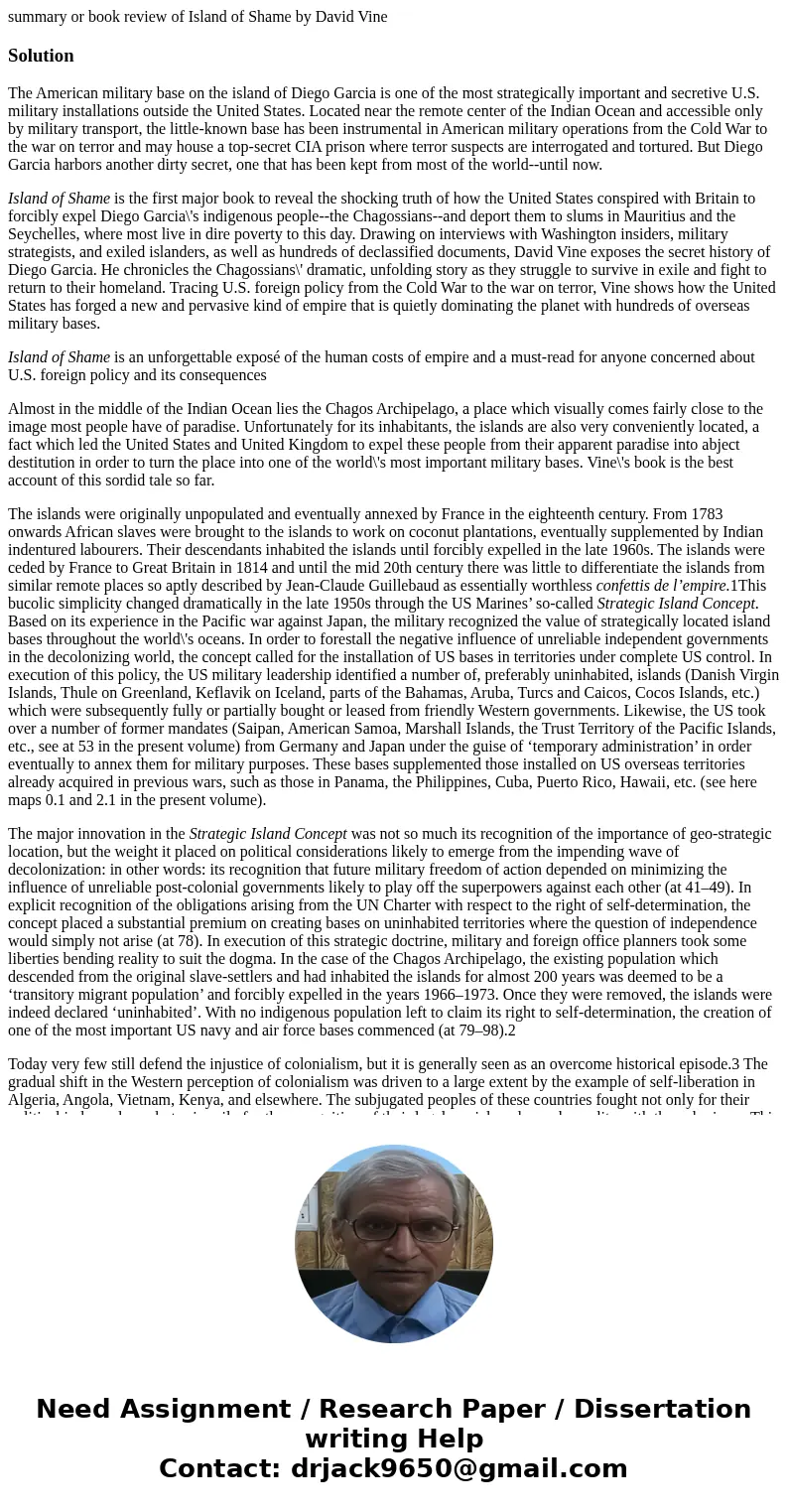
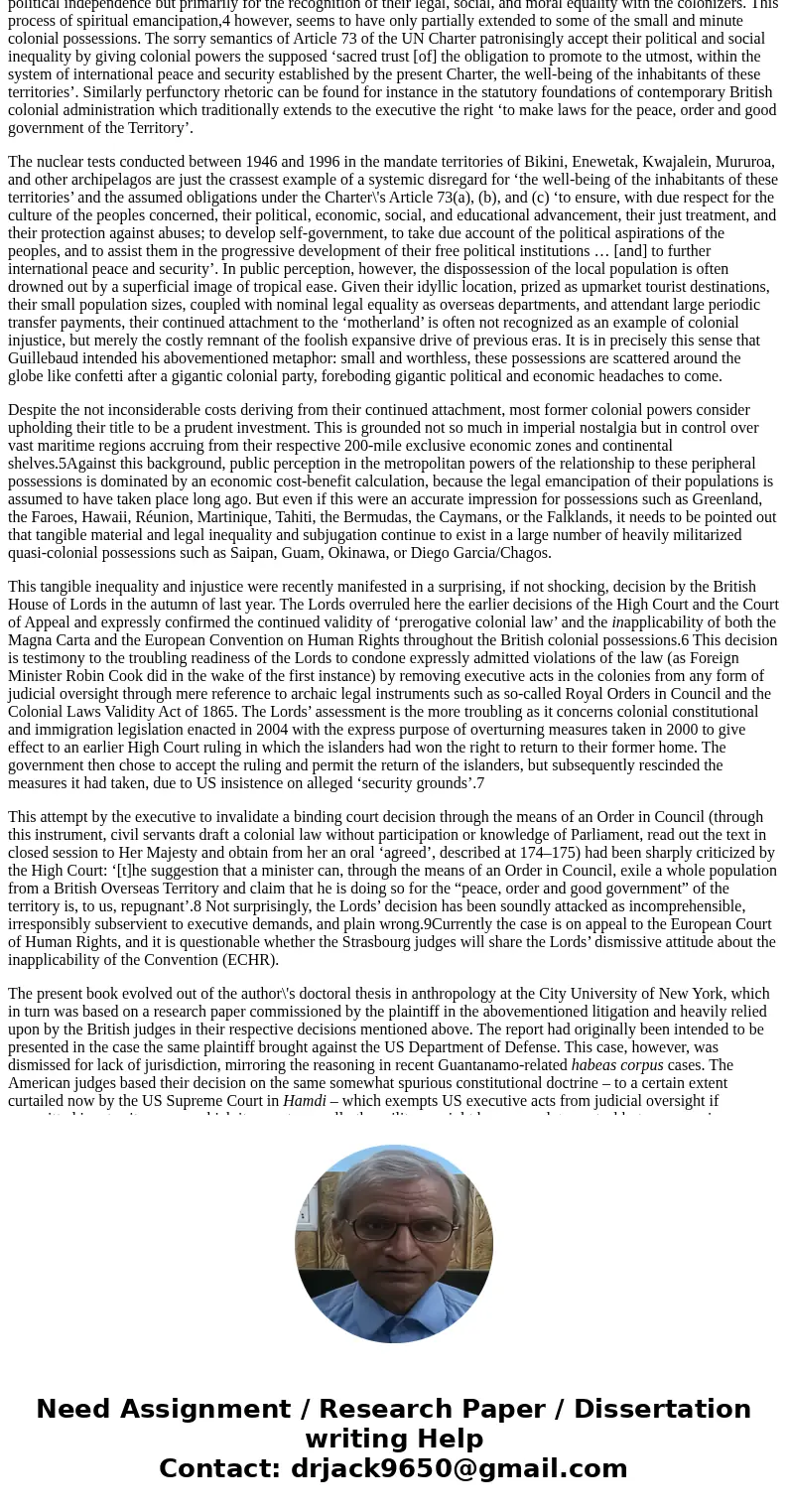
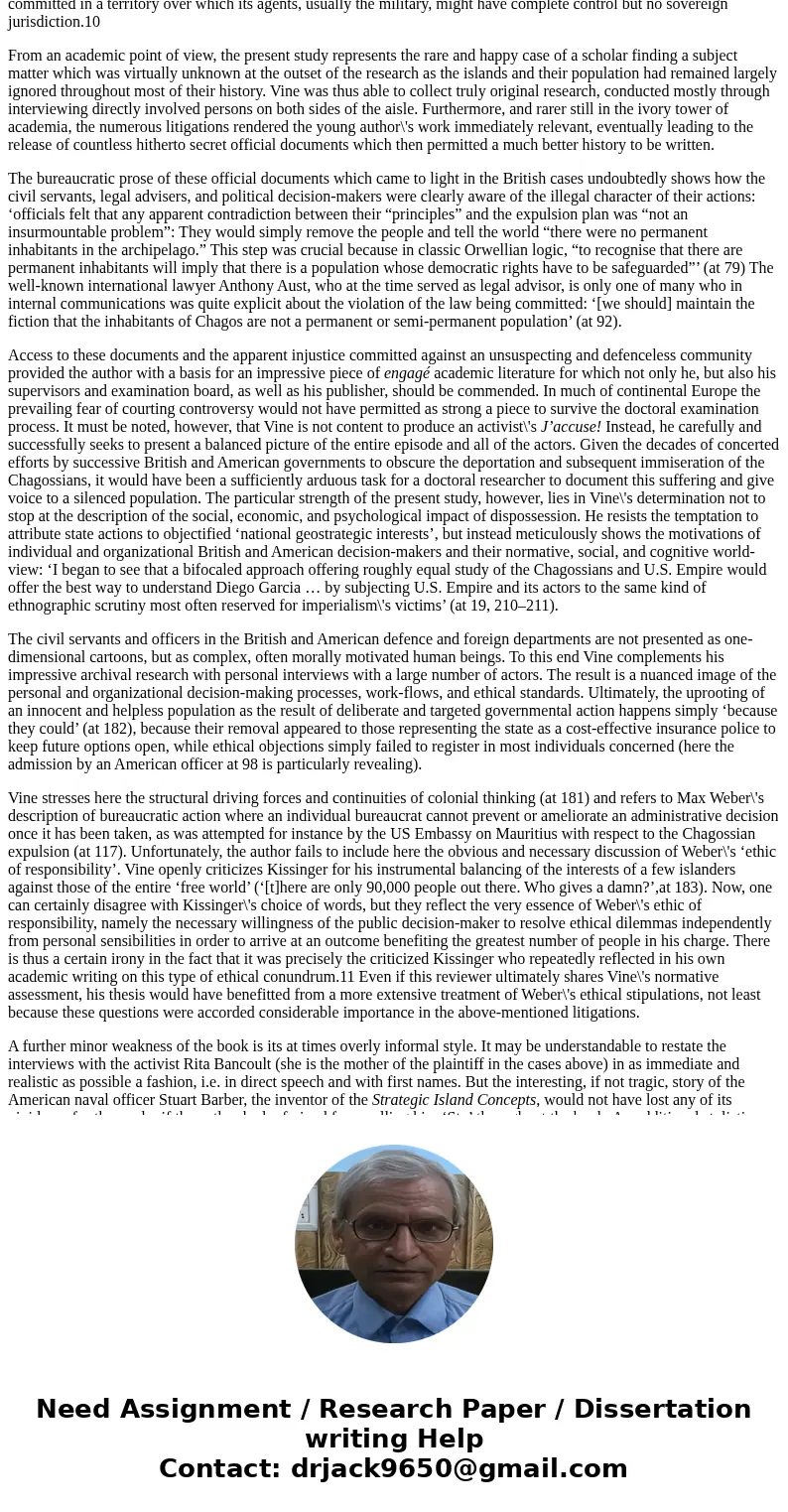
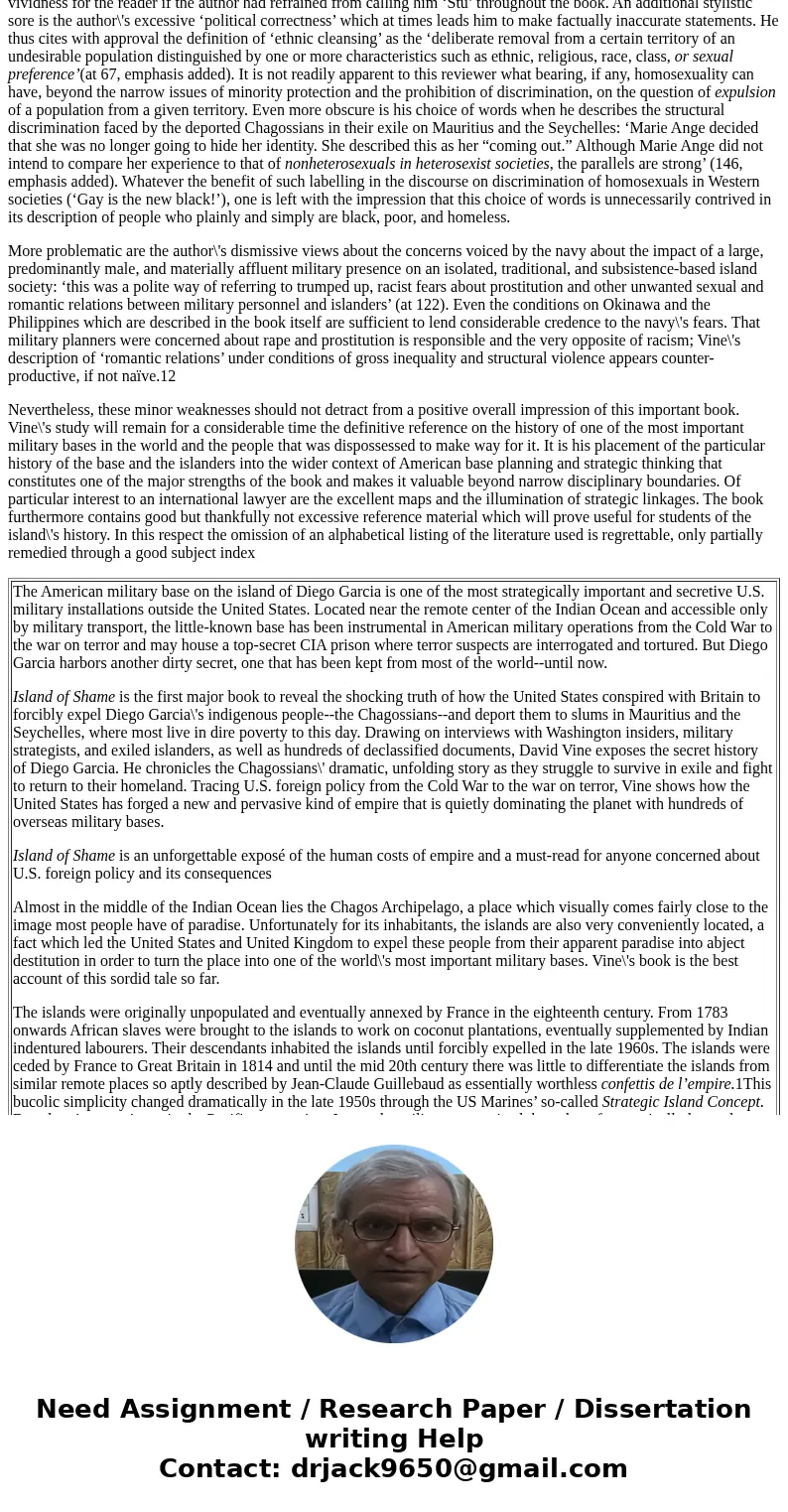
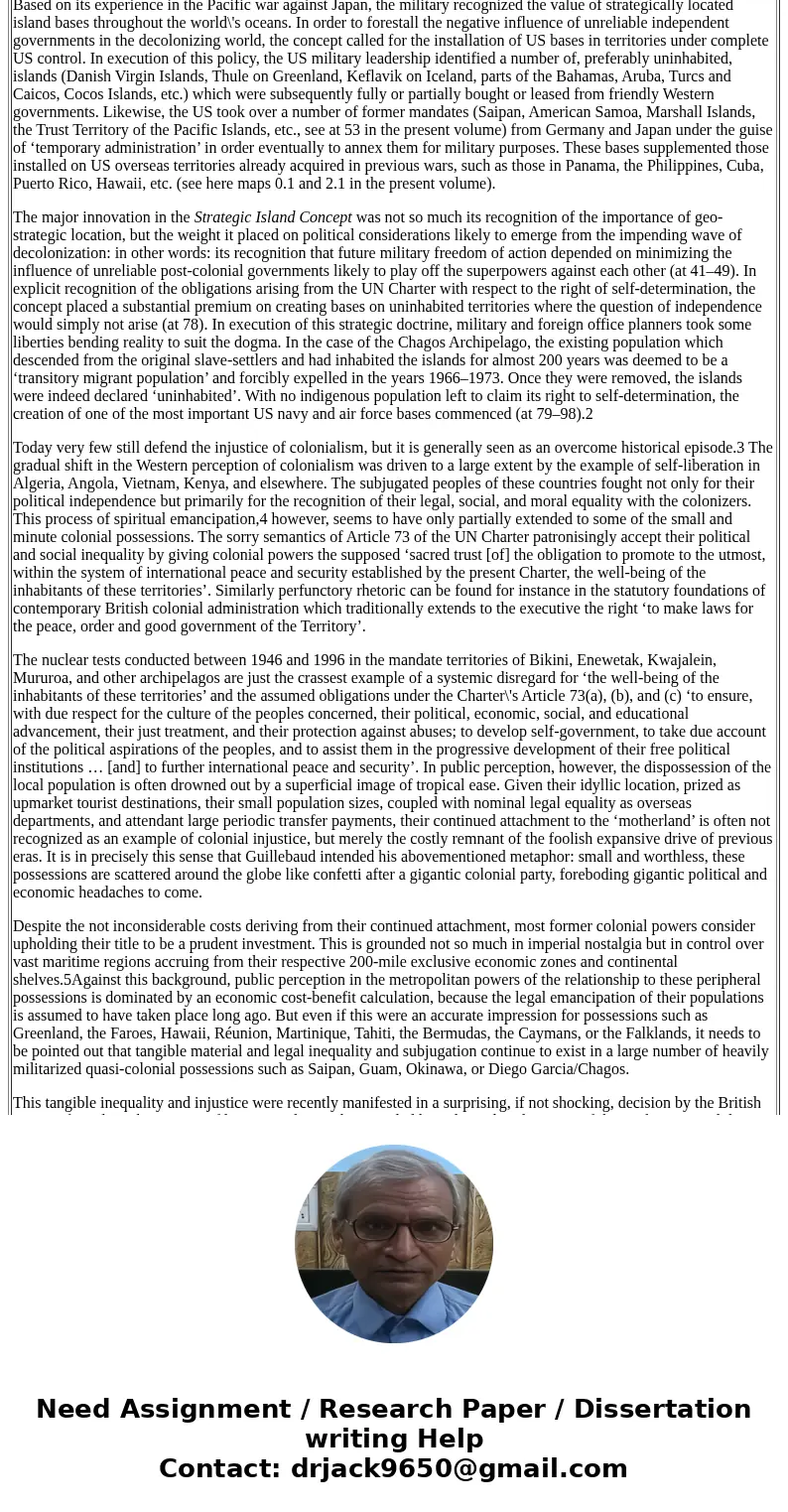
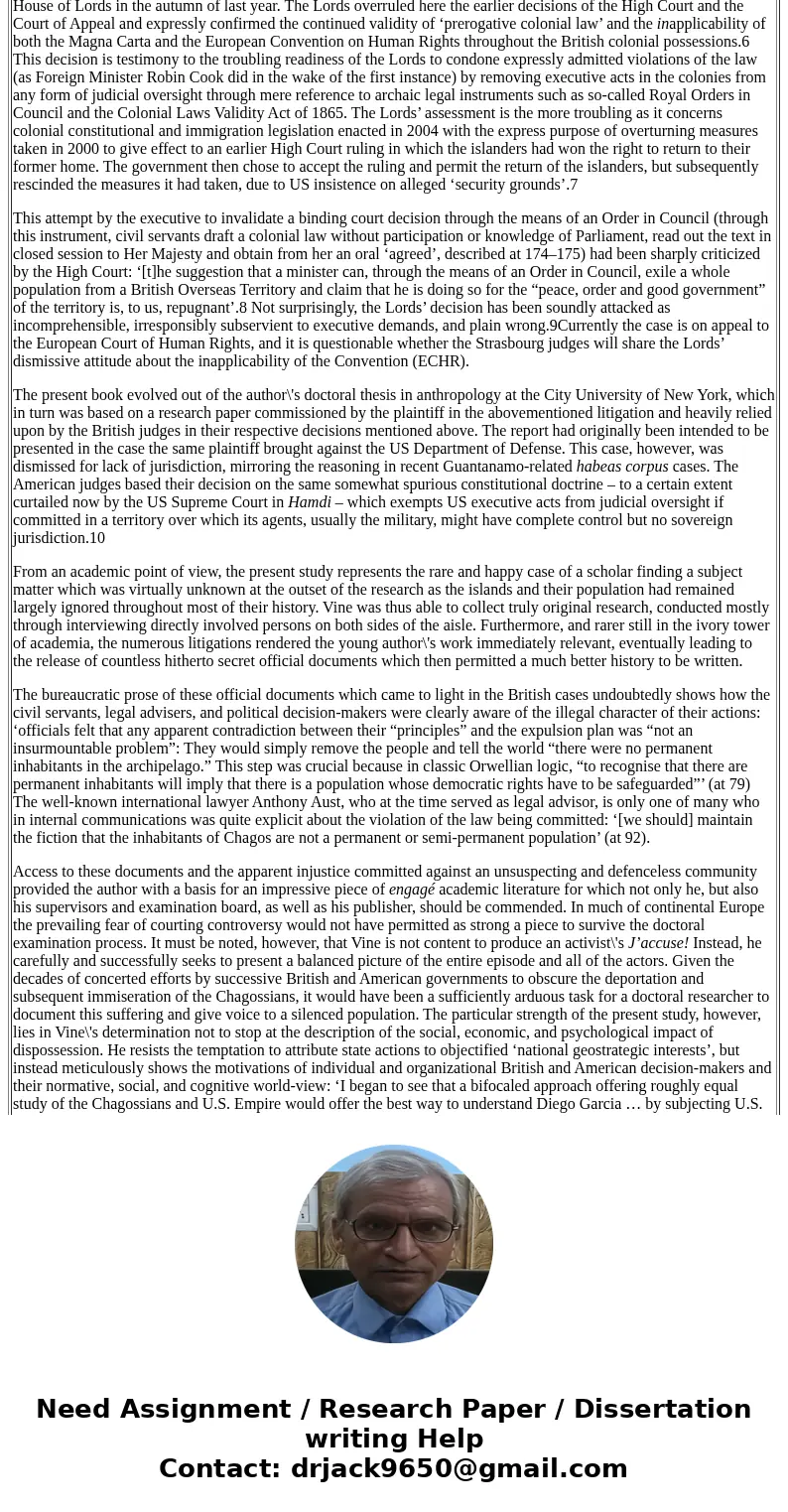
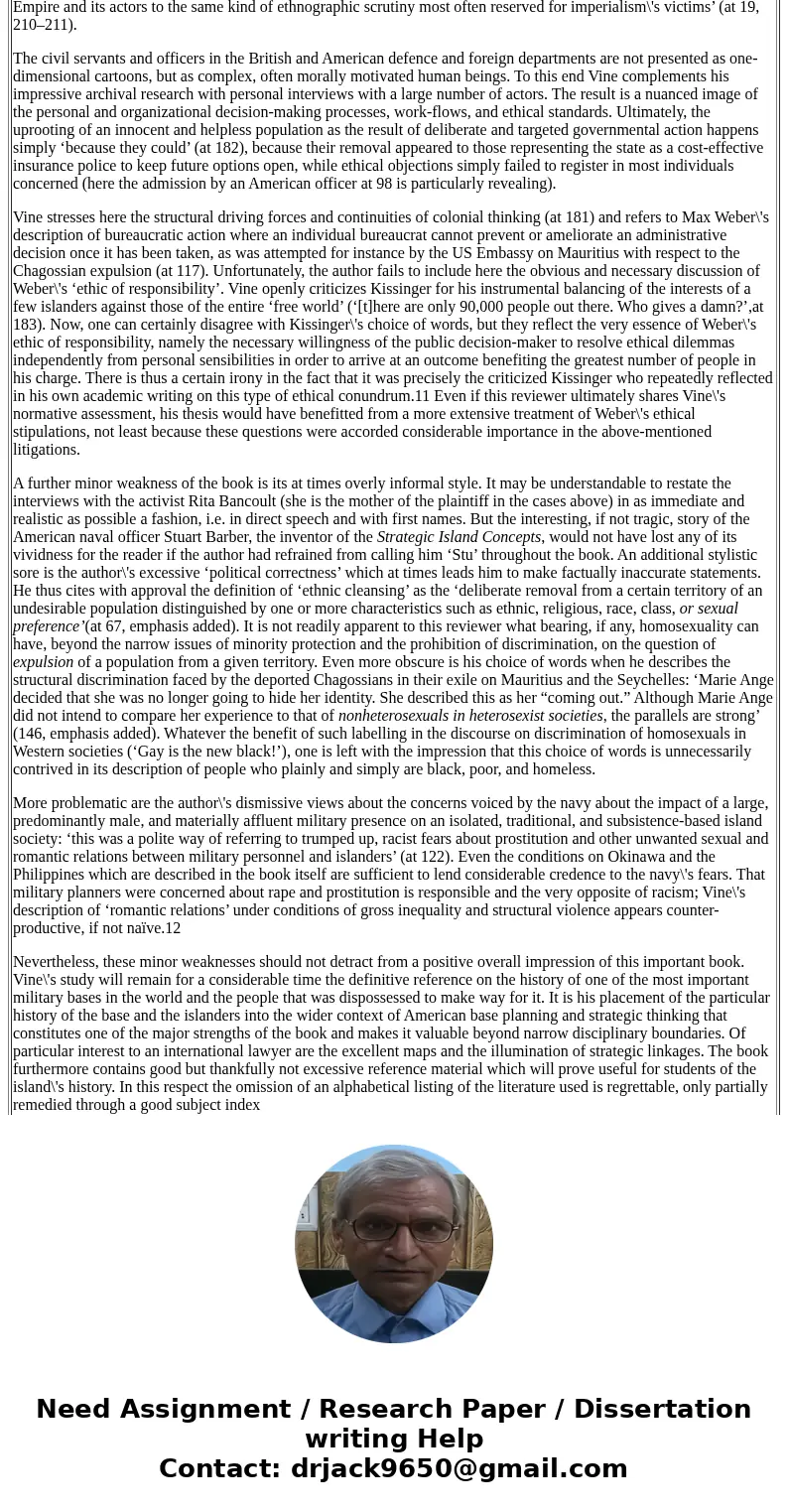
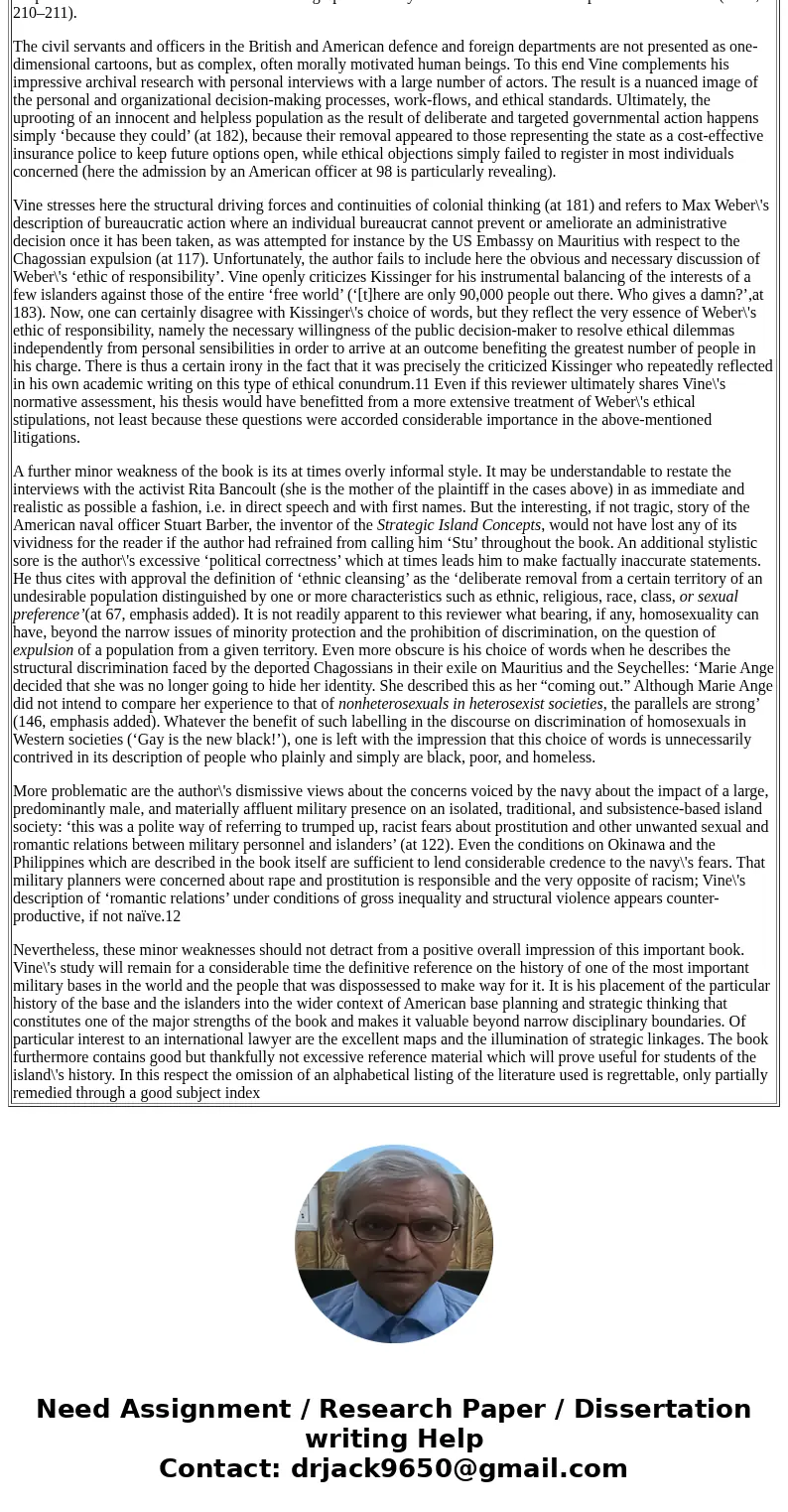
 Homework Sourse
Homework Sourse